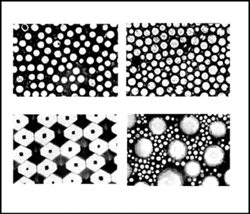
Laser Produces Better Road Signs
Gary Boas
Most of us acknowledge the messages on roadway signs, and we speed by without giving them another thought. But researchers at Zhejiang University in Hangzhou, China, are working hard to improve signage technology to better catch our eye. They have developed a laser-based solution that may improve road sign visibility.

A laser-produced retroreflective film may improve the visibility of road signs. Micrographs expose the structure of the glass beads in such films. Clockwise from bottom left, 3M Co.'s 3970, Jiaojiang Glass Reflecting Material Group Co. Ltd.'s 901, 3M's 8910 and the new film.
Signs employ several different types of reflectors to make them prominent to a driver. One of the most common is the retroreflective bead array. The glass beads, however, are approximately 50 to 100 µm in diameter and display limited retroreflective efficiency, especially in the far field.
It is difficult to produce larger beads with conventional fire- and electricity-based heating techniques, so the researchers turned to a 500-W CO2 laser. By focusing the laser on freely dropped titanic silicate glass powder, they generated 0.1- to 0.3-mm-diameter beads. Furthermore, they controlled the refractive index of the beads by adjusting the ratio of other materials in the powder.
They also have developed a means to lay smaller beads into spaces between the larger ones. Using two or three sizes of beads increases the retroreflection of the optical array because the beads contribute to reflection for different distances and directions, explained Shaomin Wang, a researcher on the project.
The developers tested the film against 3M's 8910 and 3970 films and against the 901 film produced by Jiaojiang Glass Reflecting Material Group Co. Ltd. of Zhejiang. They used a custom full-view visualizer to observe the whole angular view of light distribution and a laser power meter to measure the retroreflective power. The results suggest that the new film is far more efficient than the others for long distances and inclined incidence.
The laser-produced film may find applications in displays, ranging targets and traffic signs. The group plans to develop the film commercially, but first must develop a less expensive and more convenient way to produce it. The prototype film is more expensive than the 8910 and 901 films. Wang predicted that it would take one to two years to complete such work.
Published: September 2002